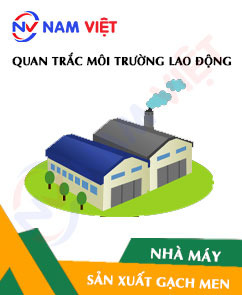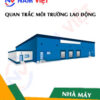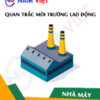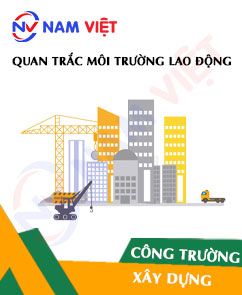Occupational environment monitoring at a ceramic tile manufacturing factory
99,000 ₫
Note: The above price is calculated for one sample, and the price may fluctuate depending on the area of the environment to be monitored and market movements. For more accurate pricing support, please refer to the price list or contact our consulting staff directly.
Monitoring the environment of a ceramic tile production factory is a session of collecting, analyzing, and evaluating workplace factors that may be harmful to workers health.
Table of Contents
Toggle1. Overview of Ceramic Tile Manufacturing Factories
a. What is a Ceramic Tile Manufacturing Factory?
Factory producing ceramic tiles is a production facility specializing in manufacturing ceramic tiles, a common building material widely used in the construction industry. Ceramic tiles are made from natural materials such as clay, sand, water, and additives. Through processing and high-temperature firing, ceramic tiles become hard, durable materials often with a glossy surface.

b. Production stages in a ceramic tile manufacturing factory
In a ceramic tile manufacturing factory, the typical production process includes the following stages:
- Material preparation: Clay, sand, water, and other additives are prepared and measured according to specific ratios.
- Mixing and grinding: Materials are mixed and ground to create a homogeneous mixture. This ensures even distribution of components and produces a fine mixture.
- Shaping: The material mixture is placed into molds to form ceramic tiles in the desired size and shape. Molds often have grooves and designs to create special surface features.
- Pressing: The material mixture is compressed in molds to achieve the desired shape and thickness. High pressure is applied to compact the particles and create tiles with good cohesion.
- Drying: Tiles are placed in drying areas to remove excess water and dry completely. Drying processes use controlled temperature and time to ensure stable and dry tiles.
- Firing: Tiles are put into kilns and fired at high temperatures to become hard, durable, and cohesive. Firing makes the tiles strong and heat-resistant.
- Quality inspection: Finished ceramic tiles are inspected to ensure compliance with standards and specific requirements. Inspection may include size, strength, water absorption, and other tile properties.
- Packing and transportation: Tiles are packaged individually or as requested by customers.

c. Machinery used in ceramic tile manufacturing factories
In ceramic tile manufacturing factories, various machines and equipment are used for production stages. Common machines include:
- Mixing machine: Used to mix clay, sand, water, and additives into a homogeneous mixture.
- Pressing machine: Used to press and compress the tile mixture into molds with the desired shape and size.
- Tile cutting machine: Used to cut and shape tiles into various sizes according to customer requirements.
- Drying machine: Used to dry and shape tiles after pressing.
- Firing kiln: Used to fire tiles at high temperatures to achieve hardness and mechanical properties.
- Tile sorting machine: Used to remove defective or low-quality tiles from production.
- Packing machine: Used to package tiles into bags or pallets for transport and storage.
- Maintenance and cleaning equipment: Used to clean and maintain machines and equipment in the factory.

d. Occupational diseases for workers in ceramic tile manufacturing factories
Workers in ceramic tile manufacturing factories may face several occupational diseases due to environmental and job-related factors. Common occupational diseases in this field include:
- Respiratory diseases: Exposure to dust and fumes from tile production can lead to bronchitis, asthma, pneumonia, and other respiratory issues.
- Skin diseases: Contact with material mixtures and additives can cause skin irritation, dermatitis, eczema, and other skin conditions.
- Hearing problems: Noise from machinery and equipment in the factory may damage hearing, causing hearing loss, deafness, and other ear-related issues.
- Spinal and musculoskeletal disorders: Repetitive work, heavy lifting, and prolonged standing can cause muscle strain, back pain, joint degeneration, and spinal problems.
- Eye diseases: Exposure to dust, chemical fumes, and strong light can cause eye irritation, conjunctivitis, eye pain, and other vision issues.
To ensure worker safety and health, ceramic tile manufacturing factories must implement protective measures, comply with occupational safety regulations, provide appropriate personal protective equipment, and train employees in workplace safety.

e. Common types of ceramic tiles on the market
On the market, there are many popular ceramic tiles used for construction and decoration. Some common types include:
- Traditional tiles: Usually dark red, widely used in residential, public, and industrial constructions.
- Facade tiles: Smooth surface tiles, often in various colors, used to highlight and decorate building exteriors.
- Glossy tiles: Tiles with reflective, shiny surfaces, used in interior decoration and high-end architecture.
- Granite tiles: Durable, strong, with natural colors, used for floors, walls, stairs, and exterior surfaces.
- Ceramic decorative tiles: Smooth, colored, and patterned tiles for interior decoration, facades, or decorative motifs.
- Wall tiles: Tiles designed for walls, in appropriate sizes and shapes for facades or wall patterns.
- Outdoor/garden tiles: Tiles with anti-slip surfaces, resistant to external conditions, used for gardens, corridors, walkways, and outdoor areas.
2. Overview of Occupational Environment Monitoring Services
a. What is occupational environment monitoring in ceramic tile manufacturing factories?
Occupational environment monitoring (or workplace environment measurement) in ceramic tile manufacturing factories involves collecting, evaluating, and analyzing measurements of workplace environmental factors to promptly address risks, minimize environmental impacts on workers’ health, and prevent occupational diseases. Occupational environment monitoring is mandatory for ceramic tile manufacturing factories.
This monitoring plays a critical role in caring for, protecting, and enhancing workers’ health because employees are the primary resource of the company and directly generate profit. Regular exposure to risk factors above permissible limits can harm workers’ health and lead to occupational diseases.
REGISTER FOR OCCUPATIONAL ENVIRONMENT MONITORING SERVICE
b. Nam Viet’s occupational environment monitoring program
Nam Viet’s occupational environment monitoring program is developed by monitoring engineers specializing in labor safety and environmental protection. To ensure worker health and safety, this program uses modern measurement methods to monitor air, water, microclimate, physical factors, dust, and other workplace conditions. This program is vital for maintaining a safe working environment and protecting workers’ health.
Additionally, Nam Viet’s program also contributes to researching and developing solutions to improve workplace environmental quality. With the dedication and professionalism of its experts, Nam Viet’s exclusive monitoring program represents a breakthrough in labor safety management and environmental protection in Vietnam.

c. Standardization in occupational environment measurement processes
Standardization in Nam Viet’s occupational environment measurement process is crucial to ensure measurement accuracy and reliability. The program follows recognized standards and procedures from Ho Chi Minh City Department of Health, ensuring high reliability of collected data for evaluating workplace environments and making informed decisions to improve working conditions and protect workers’ health.
These standardized processes are performed by experienced monitoring specialists, allowing managers and experts to trust results from An Toan Nam Viet and make accurate, valuable decisions in occupational health and environmental protection.
By applying standardization in measurement processes, Nam Viet demonstrates its commitment to ensuring safe workplaces, protecting worker health, and contributing to improved labor safety and environmental management in Vietnam.
d. Reporting occupational environment monitoring results in ceramic tile factories
Monitoring results are prepared according to Form 04, Appendix III, issued with Decree 44/2016/ND-CP in two copies: one sent to the labor facility that contracted the monitoring service, and one retained by the monitoring organization.
According to the law, the retention period of monitoring results is indefinite.

e. Frequency of occupational environment monitoring according to law
According to clause 2 of Article 18, Law on Occupational Safety and Hygiene 84/2015/QH13, employers must conduct occupational environment monitoring to assess harmful factors at least once a year.
f. Deadline for submitting occupational environment monitoring reports according to law
The deadline for submitting reports is before December 31 each year. Enterprises in production facilities must submit monitoring results to the Department of Health in the locality where the factory’s headquarters and employees are located.
When there are changes in technology, production processes, or facility upgrades that may generate new hazardous factors affecting worker health, production enterprises must update their occupational hygiene records regarding harmful factors requiring monitoring.
g. Penalties for violations of occupational environment monitoring by employers
According to Article 27 of Decree No. 12/2022/ND-CP dated 17/01/2022 on administrative penalties in labor, social insurance, and Vietnamese workers working abroad under contracts:
- Clause 2: A fine of VND 2,000,000 – 5,000,000 for employers who do not publicly inform workers at the monitoring site and controlled areas immediately after obtaining monitoring results and assessment of hazardous factors.
- Clause 3: A fine of VND 20,000,000 – 40,000,000 for employers who fail to conduct occupational environment monitoring to control health hazards as required by law.
- Clause 4: A fine of VND 40,000,000 – 60,000,000 for employers who collude with monitoring organizations to commit fraud in monitoring activities but not to the extent of criminal liability.
g. Penalties for violations of occupational environment monitoring by employers
According to Article 27 of Decree No. 12/2022/ND-CP dated 17/01/2022 on administrative penalties in labor, social insurance, and Vietnamese workers working abroad under contracts:
- Clause 2: A fine of VND 2,000,000 – 5,000,000 for employers who do not publicly inform workers at the monitoring site and controlled areas immediately after obtaining monitoring results and assessment of hazardous factors.
- Clause 3: A fine of VND 20,000,000 – 40,000,000 for employers who fail to conduct occupational environment monitoring to control health hazards as required by law.
- Clause 4: A fine of VND 40,000,000 – 60,000,000 for employers who collude with monitoring organizations to commit fraud in monitoring activities but not to the extent of criminal liability.
3. Harmful Environmental Factors for Workers in Ceramic Tile Factories
Workers in ceramic tile factories may be exposed to the following harmful environmental factors:
- Dust: The production of ceramic tiles generates stone dust and tile dust. Long-term exposure to dust may cause respiratory issues such as bronchitis, pneumonia, and prostate problems.
- Chemicals: During ceramic tile production, chemicals such as cement, asbestos, paint, and additives may be used. Exposure to these chemicals can cause skin irritation, dermatitis, allergies, and other health problems.
- Noise: Machinery and production processes in ceramic tile factories can produce loud noise. Long-term exposure can damage hearing and cause issues such as hearing loss and stress.
- Temperature: Firing tiles in kilns can generate high temperatures. Exposure to high temperatures may lead to skin cracks, burns, and body temperature disorders.
- Smoke and toxic gases: The tile firing process may produce smoke and toxic gases such as CO2, NOx, and toxic fumes from fuels. Exposure to smoke and toxic gases may cause respiratory, cardiovascular, and general health problems.
REGISTER FOR OCCUPATIONAL ENVIRONMENT MONITORING SERVICE
4. Measures to Improve Working Environment in Ceramic Tile Factories
To improve the working environment in ceramic tile factories and protect workers’ health, the following measures can be implemented:
- Dust management: Use effective dust extraction systems to reduce dust during production. Ensure clean work areas and regularly clean machinery to remove accumulated dust.
- Use of personal protective equipment (PPE): Ensure workers properly use PPE such as safety glasses, masks, gloves, protective clothing, and safety shoes to protect against direct contact with harmful substances and dust.
- Training and education: Provide occupational health and safety training for workers, including proper PPE use, safe work procedures, waste handling, and emergency measures.
- Production process adjustment: Optimize production processes to minimize exposure to harmful substances and reduce dust, smoke, and toxic gas emissions.
- Noise control: Apply noise reduction measures such as soundproofing equipment, ear protection, and providing quiet areas for workers to rest.
- Temperature management: Ensure a comfortable working environment with temperatures compliant with safety regulations.
- Waste management: Handle and dispose of waste according to regulatory guidelines to prevent environmental pollution in the workplace.
- Health assessment and monitoring: Conduct regular health check-ups to detect early health issues related to the working environment.
- Create a comfortable working environment: Improve workspace by providing natural light, air conditioning, and proper ventilation to reduce the concentration of harmful substances and emissions.
- Regularly conduct occupational environment monitoring in the factory, collect and analyze harmful factors affecting workers, and adjust measures to reduce hazards to prevent occupational diseases.
5. Benefits of Periodic Ceramic Tile Factory Environment Monitoring
An Toan Nam Viet provides businesses with excellent benefits when using occupational environment monitoring services in accordance with Decree 44/2016/NĐ – CP on the management and control of harmful factors in the working environment affecting workers.
- Businesses can proactively control harmful factors in workshops or factories.
- Receive recommendations for measures to reduce harmful factors and improve the quality of the working environment.
- Indirectly protect human resources, the key factor in business development.
- Reduce the impact of occupational diseases on workers’ health, minimizing future medical treatment costs.
- Improved workers’ health ensures product quality and maintains production output.
- Comply with labor safety laws and avoid legal risks.
- Enhance credibility and professionalism, elevating the company’s brand.
An Toan Viet’s environment monitoring service is a solution to reduce occupational disease hazards, contributing to a clean and high-quality working environment.

6. Nationwide Occupational Environment Monitoring Center
An Toan Viet Occupational Environment Monitoring Center is a professional unit monitoring and measuring occupational environment quality across all provinces in Vietnam. With experienced monitoring specialists, the center uses modern measuring equipment to ensure accuracy and reliability.
In addition to monitoring services, the center supports clients in planning, processing, and tracking occupational environment issues. With the motto “customer-centric,” the center prioritizes customer satisfaction and delivers optimal solutions for businesses.
REGISTER FOR OCCUPATIONAL ENVIRONMENT MONITORING SERVICE
With investments in technology, equipment, and workforce, An Toan Viet’s monitoring center has become a reputable unit in occupational environment monitoring in Ho Chi Minh City with the following objectives:
- We value our brand reputation and service quality.
- We provide clients with the best and most suitable solutions.
- Alongside experienced Masters and Engineers, aiming to protect the environment and benefit businesses.
- Clients using An Toan Viet monitoring services receive professional support from experts and the best cost advantages.
The occupational environment monitoring process at An Toan Viet includes the following steps:
- Before monitoring, ensure all equipment is calibrated according to legal regulations.
- Follow the committed occupational environment monitoring procedures with the Department of Health.
- Report monitoring results truthfully to employers.
- If results indicate unsafe conditions, An Toan Viet will support remediation measures and the workplace will:
- Implement measures to improve working conditions to minimize harmful effects and prevent occupational diseases.
- Organize health check-ups to detect occupational diseases early for workers in unsafe positions.
- Provide material compensation to workers according to labor law regulations.

7. Occupational Environment Monitoring Pricing
To help businesses conduct professional and effective occupational environment monitoring, An Toan Viet provides a detailed price list for monitoring services with quality and reasonable costs.
- Our price list provides detailed information on all monitoring services offered, including costs for travel, measurement, analysis, and reporting. Clients can trust the accuracy and reliability of our monitoring reports.
- We commit to offering competitive and reasonable prices, while providing fast and professional consultation for all monitoring service inquiries.
- With An Toan Viet’s monitoring price list, clients can easily select service packages suitable for their needs, ensuring maximum satisfaction with professional service quality.
No comments yet












Review Occupational environment monitoring at a ceramic tile manufacturing factory
There are no reviews yet.